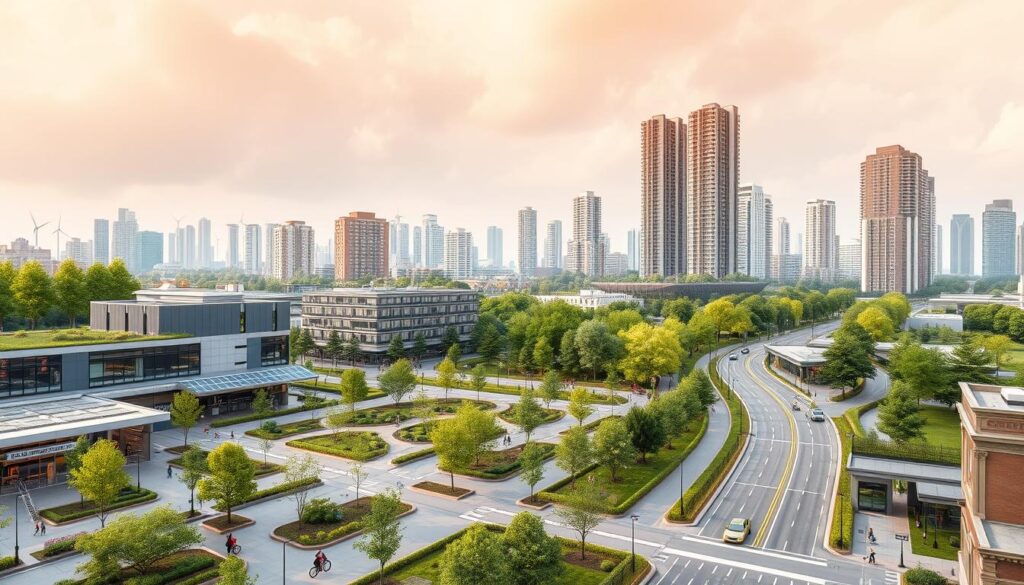Did you know that infrastructure development is responsible for a significant portion of global greenhouse gas emissions? As the world grapples with climate change, it’s becoming increasingly clear that community-focused design is crucial for creating a more sustainable future.
Sustainable infrastructure design is not just about building roads and buildings; it’s about creating communities that are resilient, sustainable, and beneficial to both the environment and society. By prioritizing community needs, we can create infrastructure that supports economic growth while minimizing its ecological footprint.
Key Takeaways
- Community-focused design is key to sustainable infrastructure development.
- Sustainable infrastructure can support economic growth while reducing environmental impact.
- Prioritizing community needs is crucial for creating resilient and sustainable communities.
- Infrastructure development has a significant impact on greenhouse gas emissions.
- Sustainable infrastructure design can help mitigate the effects of climate change.
Understanding Sustainable Infrastructure Design
Sustainable infrastructure is not just about buildings and roads; it’s about creating vibrant, resilient communities through thoughtful design. Effective sustainable infrastructure design considers the cultural, social, and economic contexts of a neighborhood, enhancing the quality of life for its residents.
At its core, sustainable infrastructure design is about more than just arranging physical spaces; it’s about fostering interactions among residents and promoting a sense of community. This approach to design is crucial in today’s rapidly urbanizing world.
Definition of Sustainable Infrastructure
Sustainable infrastructure refers to the design and implementation of physical structures that minimize environmental impact while promoting social and economic benefits. This includes the use of eco-friendly materials, efficient energy systems, and designs that encourage community interaction.
As noted by urban planning expert, “Sustainable infrastructure is the backbone of any thriving community, providing the foundation for economic growth, social equity, and environmental stewardship.”
“The way we design our infrastructure will determine the kind of communities we have in the future.”
Importance for Communities
Sustainable infrastructure design plays a vital role in enhancing community life. By prioritizing community-focused sustainable design, cities can create public spaces that foster a sense of belonging and promote social cohesion.
- Enhances quality of life
- Promotes social equity
- Supports economic development
Role in Climate Resilience
In the face of climate change, sustainable infrastructure design is crucial for building resilience. By incorporating green infrastructure such as green roofs, rain gardens, and permeable pavements, communities can better manage stormwater runoff and reduce the risk of flooding.
The importance of sustainable infrastructure design cannot be overstated. As we move forward, it’s essential that we prioritize eco-friendly urban planning and community-focused sustainable design to create a more sustainable and resilient future for all.
Key Principles of Sustainable Design

The core of sustainable infrastructure lies in its design principles, which aim to minimize environmental impact while maximizing community benefits. Sustainable construction focuses on natural obligation and resource efficiency throughout the building’s lifecycle, encompassing design, construction, operation, maintenance, and even demolition or deconstruction.
Resource Efficiency
Resource efficiency is a cornerstone of sustainable design, ensuring that materials and energy are used optimally. This involves selecting materials that are recycled, recyclable, or sustainably sourced, and implementing energy-efficient systems that reduce overall consumption. By doing so, we not only reduce waste but also lower the environmental footprint of our infrastructure projects.
Efficient use of resources also means considering the long-term availability of materials and the potential for future recycling or reuse. This approach helps in minimizing the environmental impacts associated with extracting, processing, and transporting materials.
Social Equity
Social equity is about ensuring that the benefits and burdens of infrastructure development are distributed fairly among all members of the community. This principle emphasizes the need for inclusive design that considers the needs of diverse populations, including vulnerable groups such as the elderly, children, and those with disabilities.
By prioritizing social equity, sustainable design can help create more cohesive and resilient communities. This involves engaging with local stakeholders to understand their needs and preferences, thereby fostering a sense of ownership and community pride in infrastructure projects.
Long-term Viability
Long-term viability refers to the ability of infrastructure to remain functional, relevant, and sustainable over its entire lifecycle. This principle requires considering future challenges and opportunities, such as climate change, technological advancements, and demographic shifts.
Designing for long-term viability means being adaptable and resilient. It involves using materials and construction methods that can withstand future environmental conditions and societal needs, thereby reducing the need for costly repairs or replacements.
In conclusion, the key principles of sustainable design—resource efficiency, social equity, and long-term viability—are interlinked and crucial for creating infrastructure that supports both the environment and the community. By embracing these principles, we can develop infrastructure that is not only sustainable but also resilient and beneficial for generations to come.
Community Engagement in the Design Process
The success of sustainable infrastructure projects hinges on the level of community engagement and participation in the design process. Community-centric sustainable development is not just a buzzword; it’s a critical component of environmentally conscious infrastructure planning.
Importance of Local Input
Local input is invaluable in the design process. It ensures that the infrastructure developed is tailored to the specific needs and expectations of the community. By involving local residents, planners can gain a deeper understanding of the community’s needs, preferences, and concerns.
This involvement can lead to more effective and sustainable solutions. For instance, local residents can provide insights into historical or cultural aspects of the area that might not be immediately apparent to outside planners.
Methods for Community Involvement
There are several methods to involve the community in the design process. These include:
- Public meetings and hearings
- Surveys and questionnaires
- Community workshops
- Online engagement platforms
Each of these methods has its own advantages and can be chosen based on the specific needs and preferences of the community.
Building Trust and Transparency
Building trust and transparency is crucial in community engagement. This can be achieved by:
- Clearly communicating the goals and objectives of the project
- Providing regular updates on the project’s progress
- Being open to feedback and willing to make adjustments based on community input
By doing so, planners can foster a collaborative environment where the community feels valued and invested in the project’s success.
Effective community engagement is a cornerstone of successful sustainable infrastructure development. By prioritizing local input, utilizing various methods for community involvement, and building trust and transparency, planners can create infrastructure that is not only sustainable but also meets the needs of the community.
Assessing Community Needs
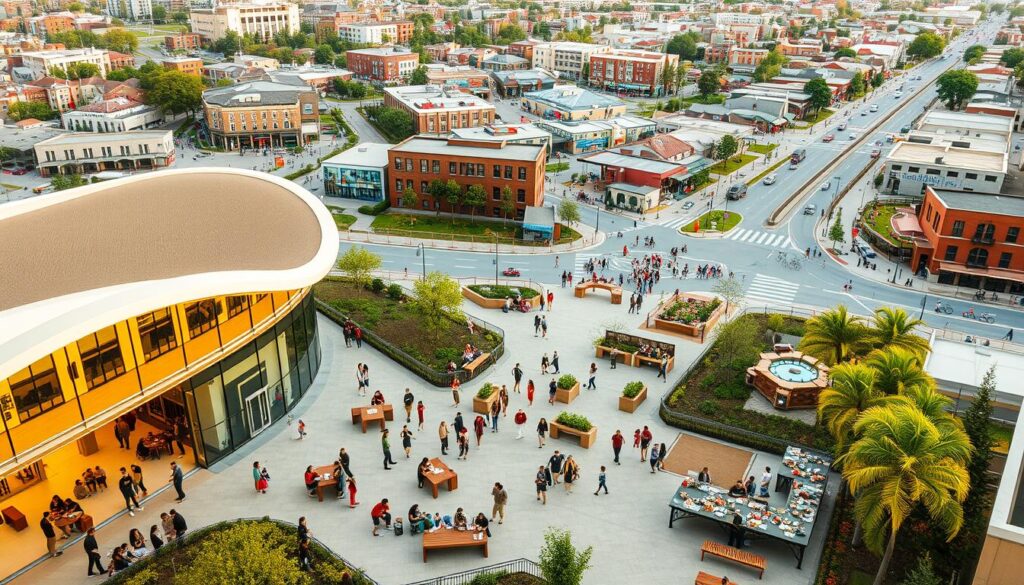
Understanding the unique characteristics of a neighborhood is vital for effective infrastructure design. Assessing community needs involves a comprehensive approach that includes understanding the local demographics, challenges, and aspirations.
Conducting Community Surveys
One of the primary methods for assessing community needs is through conducting surveys. These surveys help gather information about the community’s perceptions, needs, and expectations. For instance, a survey might ask residents about their concerns regarding transportation, public spaces, or energy usage. By engaging directly with the community, planners can ensure that the infrastructure design aligns with the community’s needs. For more information on conducting community needs assessments, visit Galaxy Digital’s blog on community needs.
Analyzing Demographic Data
Analyzing demographic data is another crucial step in understanding community needs. This involves examining data on population size, age distribution, income levels, and other relevant factors. By analyzing this data, planners can identify trends and patterns that inform infrastructure design decisions. For example, an area with a high proportion of young families might require more parks and recreational facilities.
Identifying Local Challenges
Identifying local challenges is essential for designing infrastructure that addresses the community’s specific needs. This could involve assessing environmental challenges, such as flood risk, or social challenges, such as access to public transportation. By understanding these challenges, planners can develop targeted solutions that enhance the quality of life for residents.
To illustrate the importance of assessing community needs, consider the following table that outlines the key components of a community needs assessment:
| Component | Description | Example |
|---|---|---|
| Community Surveys | Gathering information directly from residents | Surveys on public transportation needs |
| Demographic Analysis | Examining population data to identify trends | Analyzing age distribution to plan schools |
| Local Challenge Identification | Assessing specific challenges faced by the community | Identifying areas prone to flooding |
By integrating these components, planners can develop a comprehensive understanding of the community’s needs, leading to more effective and sustainable infrastructure design. As seen in the table, a thorough assessment involves multiple facets, ensuring that no critical aspect is overlooked.
In conclusion, assessing community needs is a multifaceted process that is crucial for social impact infrastructure design and sustainable urban design solutions. By engaging with the community, analyzing demographic data, and identifying local challenges, planners can create infrastructure that truly serves the people.
Green Building Materials
Green building materials play a crucial role in reducing the ecological footprint of infrastructure projects. The shift towards sustainable infrastructure design is heavily influenced by the adoption of eco-friendly materials that minimize environmental impact.
The selection of building materials is a critical aspect of sustainable construction practices. Materials such as recycled plastics, locally sourced stone, and renewable resources like bamboo are gaining popularity due to their lower environmental footprint.
Sustainable Sourcing
Sustainable sourcing is a key principle in the selection of green building materials. It involves choosing materials that are harvested or produced in a way that minimizes environmental damage. For instance, wood from certified sustainable forests is a preferred choice for many builders.
According to the U.S. Green Building Council, sustainable sourcing not only reduces the environmental impact but also promotes eco-friendly practices throughout the supply chain.
Benefits of Eco-friendly Materials
Eco-friendly materials offer numerous benefits, including reduced energy consumption, lower greenhouse gas emissions, and improved indoor air quality. These materials contribute to creating healthier living and working environments.
A notable example is the use of low-VOC (Volatile Organic Compound) paints, which significantly improve indoor air quality by reducing the emission of harmful chemicals.
“The use of green building materials is not just a trend; it’s a necessity for creating a sustainable future.” –
Innovations in Material Technology
The field of green building materials is witnessing rapid innovation, with new materials and technologies being developed to enhance sustainability. Examples include advanced recycled materials, bio-based materials, and materials with improved energy efficiency.
| Material | Description | Benefits |
|---|---|---|
| Recycled Steel | Made from post-consumer steel waste | Reduces landfill waste, conserves natural resources |
| Bamboo | Highly renewable due to its fast growth rate | Sustainable, durable, and aesthetically pleasing |
| Low-VOC Paints | Paints with low volatile organic compounds | Improves indoor air quality, healthier for occupants |
In conclusion, the adoption of green building materials is a critical step towards achieving sustainable infrastructure design. By focusing on sustainable sourcing, understanding the benefits of eco-friendly materials, and embracing innovations in material technology, we can significantly reduce the environmental impact of our built environment.
Transportation Infrastructure and Community Impact
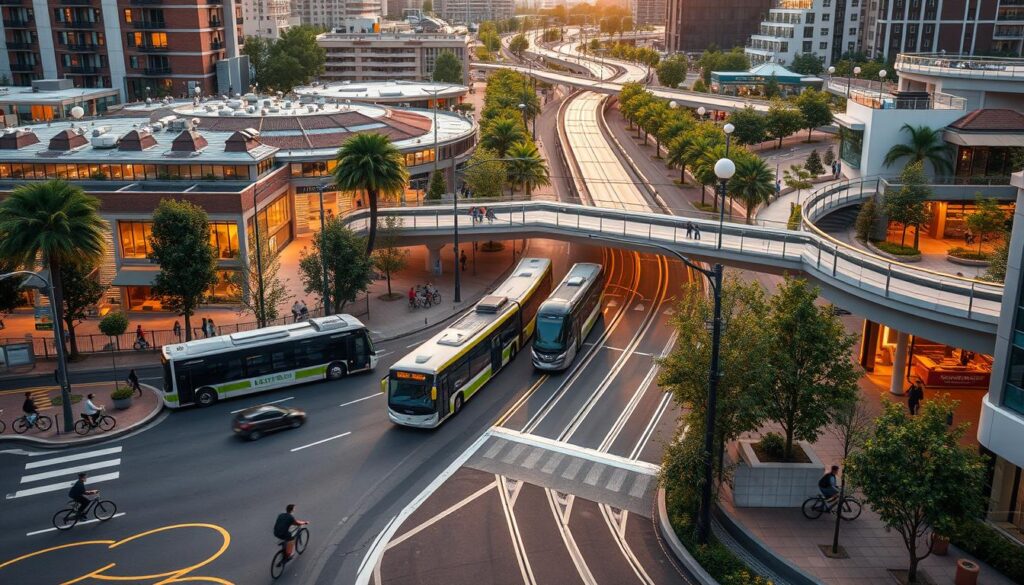
Community-focused sustainable design in transportation infrastructure is crucial for creating vibrant, inclusive, and environmentally conscious neighborhoods. Effective transportation systems are vital for the accessibility and connectivity of a neighborhood, encompassing a mix of transportation options such as public transit, cycling paths, and pedestrian walkways.
Public Transportation Solutions
Public transportation is a cornerstone of sustainable architecture for communities, offering residents a convenient, affordable, and environmentally friendly alternative to personal vehicles. By investing in efficient public transit systems, communities can reduce traffic congestion, lower emissions, and enhance overall quality of life.
- Implementing bus rapid transit (BRT) systems
- Enhancing rail networks for better connectivity
- Incorporating smart traffic management technologies
Walkable City Design
Walkable city design is another critical aspect of community-focused sustainable design, promoting physical activity, social interaction, and local economic growth. By creating pedestrian-friendly environments, cities can become more livable and attractive to residents and visitors alike.
- Designing wide, well-lit sidewalks
- Implementing traffic calming measures
- Creating public spaces that encourage community engagement
Integrating Cycling Infrastructure
Integrating cycling infrastructure into urban planning is essential for sustainable transportation, providing a safe and efficient way for people to move around the city. This not only reduces reliance on fossil fuels but also contributes to a healthier population.
- Developing dedicated bike lanes
- Installing bike-share systems
- Ensuring secure bike parking facilities
By prioritizing these elements, communities can develop transportation infrastructure that supports sustainable community development, enhancing the overall quality of life for residents.
Energy-efficient Infrastructure
The shift towards energy-efficient infrastructure is a key component of environmentally conscious infrastructure planning, enabling communities to reduce their environmental impact while promoting sustainable development.
Energy-efficient infrastructure encompasses a range of technologies and strategies, including renewable energy options, smart grids, and energy storage solutions. These elements work together to minimize energy consumption and maximize the use of renewable resources.
Renewable Energy Options
Renewable energy sources, such as solar, wind, and hydroelectric power, are crucial for reducing reliance on fossil fuels. Community-centric sustainable development can be achieved by integrating these sources into the energy grid.
- Solar energy harnessed through photovoltaic panels
- Wind energy captured using wind turbines
- Hydroelectric power generated from water flow
Smart Grids and Energy Storage
Smart grids are advanced energy distribution systems that manage energy supply and demand efficiently. They incorporate energy storage solutions to stabilize the grid and ensure a reliable energy supply.
- Advanced grid management systems
- Battery storage technologies
- Grid-scale energy storage solutions
Community Solar Initiatives
Community solar initiatives allow multiple individuals or organizations to share the benefits of a single solar array. This approach makes solar energy more accessible to a wider range of people.
- Shared solar programs
- Community solar gardens
- Subscription-based solar services
By adopting energy-efficient infrastructure, communities can significantly reduce their carbon footprint and contribute to a more sustainable future.
Stormwater Management Techniques

Sustainable infrastructure design relies heavily on innovative stormwater management solutions. Effective stormwater management is crucial for reducing the environmental impact of urban development.
Various techniques are employed to manage stormwater runoff, including green roofs, rain gardens, bioswales, and permeable pavements. These methods not only mitigate flooding but also contribute to sustainable urban design solutions.
Green Roofs Explained
Green roofs are a highly effective stormwater management technique. They involve covering rooftops with vegetation, which absorbs rainwater and reduces runoff. This approach not only manages stormwater but also provides insulation and creates habitats for wildlife.
According to
“Green Infrastructure: A People’s Guide to Saving Water and Money” by the U.S. Environmental Protection Agency, green roofs can retain up to 70% of rainfall, significantly reducing stormwater runoff.
This makes them an attractive option for urban areas where stormwater management is a challenge.
Rain Gardens and Bioswales
Rain gardens and bioswales are another effective method for managing stormwater. These are shallow depressions planted with native vegetation that absorb and filter rainwater. They are particularly useful in urban areas where space is limited.
- Rain gardens reduce stormwater runoff by allowing water to infiltrate the ground.
- Bioswales are designed to capture and filter stormwater, removing pollutants before they enter waterways.
Permeable Pavements
Permeable pavements are a type of infrastructure that allows stormwater to percolate through the surface, reducing runoff. This technique is especially useful for parking lots and roads.
By incorporating permeable pavements into urban design, cities can significantly reduce the burden on stormwater drainage systems. This not only mitigates flooding but also helps to recharge groundwater.
Social Spaces in Infrastructure Planning
The integration of social spaces within infrastructure design is essential for creating vibrant, community-focused environments. Social spaces such as parks, playgrounds, and community centers are vital for encouraging social interactions and recreational activities. These spaces should be easily accessible, safe, and well-maintained to maximize their benefits to the community.
Parks and Recreation Areas
Parks and recreation areas are fundamental components of social infrastructure. They provide residents with spaces for leisure, exercise, and socialization. According to the Urban Land Institute, incorporating green spaces into urban planning can significantly enhance community resilience and well-being.
The benefits of parks and recreation areas include improved mental health, increased opportunities for physical activity, and enhanced community cohesion. Effective design should consider factors such as accessibility, safety, and the incorporation of diverse amenities to cater to different age groups and interests.
Community Gathering Spaces
Community gathering spaces, such as community centers and public plazas, play a crucial role in fostering social connections among residents. These spaces host various events and activities that promote community engagement and cultural exchange. As noted by experts, “community gathering spaces are essential for building strong, resilient communities” (World Civil Society).
A well-designed community gathering space should be flexible, adaptable, and inclusive, accommodating a range of activities and events. This can include public art installations, cultural festivals, and community programs, thereby enriching the social fabric of the community.
Enhancing Urban Agriculture
Urban agriculture is another critical aspect of social infrastructure, providing communities with access to fresh produce and promoting sustainable living practices. Incorporating urban agriculture into infrastructure planning can take various forms, including community gardens, rooftop gardens, and urban farms.
| Type of Urban Agriculture | Benefits | Examples |
|---|---|---|
| Community Gardens | Promotes community engagement, provides fresh produce | Shared plots in urban parks |
| Rooftop Gardens | Utilizes underused space, improves air quality | Rooftop farms in commercial buildings |
| Urban Farms | Produces significant quantities of fresh produce, creates jobs | Large-scale urban farming projects |
By integrating social spaces into infrastructure planning, cities can enhance the quality of life for their residents, promote community cohesion, and support sustainable development. As urbanization continues to grow, the importance of incorporating green infrastructure development and community-focused sustainable design into urban planning cannot be overstated.
“The future of our cities depends on our ability to create spaces that are not only sustainable but also vibrant and inclusive.”
Economic Benefits of Sustainable Infrastructure

Investing in sustainable infrastructure not only supports environmental goals but also yields significant economic returns for local communities. By focusing on sustainable design, communities can experience a range of economic benefits that contribute to their overall prosperity.
Stimulating Local Economies through Job Creation
One of the most immediate economic benefits of sustainable infrastructure projects is the creation of new job opportunities. According to a report by the Prime Group, sustainable infrastructure investments can lead to a significant increase in employment rates in local communities.
As sustainable infrastructure projects often require specialized labor and materials, they tend to stimulate local economies. For instance, the construction of green buildings or renewable energy facilities can create a demand for skilled workers, thereby boosting local employment.
Cost Savings in Construction and Maintenance
Sustainable infrastructure is designed to be more efficient and durable, leading to substantial cost savings over time. By incorporating eco-friendly materials and designs, communities can reduce the need for frequent repairs and maintenance, thereby lowering long-term costs.
A study on cutting construction costs highlights the potential for sustainable practices to reduce expenditure on infrastructure projects. The use of locally sourced materials and innovative construction techniques can further contribute to cost efficiency.
| Economic Benefit | Description | Potential Impact |
|---|---|---|
| Job Creation | New employment opportunities in construction and maintenance | Boosts local economy, reduces unemployment |
| Cost Savings | Reduced maintenance and repair costs due to durable designs | Lowers long-term expenditure, reallocates funds to other community needs |
| Long-term Viability | Enhanced economic stability through sustainable practices | Attracts investments, promotes sustainable growth |
Ensuring Long-term Economic Viability
Sustainable infrastructure not only provides immediate economic benefits but also ensures long-term economic viability. By investing in sustainable designs and materials, communities can create infrastructure that supports economic growth over the long term.
“Sustainable infrastructure is key to unlocking economic growth while minimizing environmental impact. It’s a win-win for communities looking to thrive in a sustainable future.”
As communities continue to evolve, the importance of sustainable infrastructure in supporting economic development cannot be overstated. By prioritizing eco-friendly urban planning and sustainable infrastructure design, communities can reap the economic benefits while contributing to a more sustainable future.
Case Studies of Successful Projects
Through case studies, we can understand the impact of community-centric sustainable development on infrastructure projects. By examining real-world examples, we gain insights into effective strategies and potential pitfalls.
Notable U.S. Projects
The United States has seen numerous successful sustainable infrastructure projects. For instance, the revitalization of the Los Angeles River has transformed a neglected area into a vibrant public space, promoting sustainable urban design solutions. Such projects demonstrate the potential for positive change in urban environments.
Another example is the redevelopment of waterfront areas, which has been instrumental in boosting local economies and enhancing community engagement.
Lessons Learned from Failures
Not all infrastructure projects achieve their intended goals. Analyzing failures provides valuable lessons. For example, projects that neglect community input often face resistance and delays. Understanding these challenges can help in developing more effective strategies for future projects.
Moreover, failures can highlight the importance of flexibility and adaptability in project planning. By learning from these experiences, developers can create more resilient and community-focused infrastructure.
Replicating Success in Different Regions
Replicating successful projects in different regions requires careful consideration of local contexts. This involves understanding regional needs, cultural nuances, and environmental conditions. By tailoring sustainable urban design solutions to specific areas, developers can enhance the likelihood of success.
Furthermore, collaboration with local stakeholders is crucial. Engaging with the community ensures that projects meet local needs and fosters a sense of ownership among residents.
Future Trends in Sustainable Infrastructure
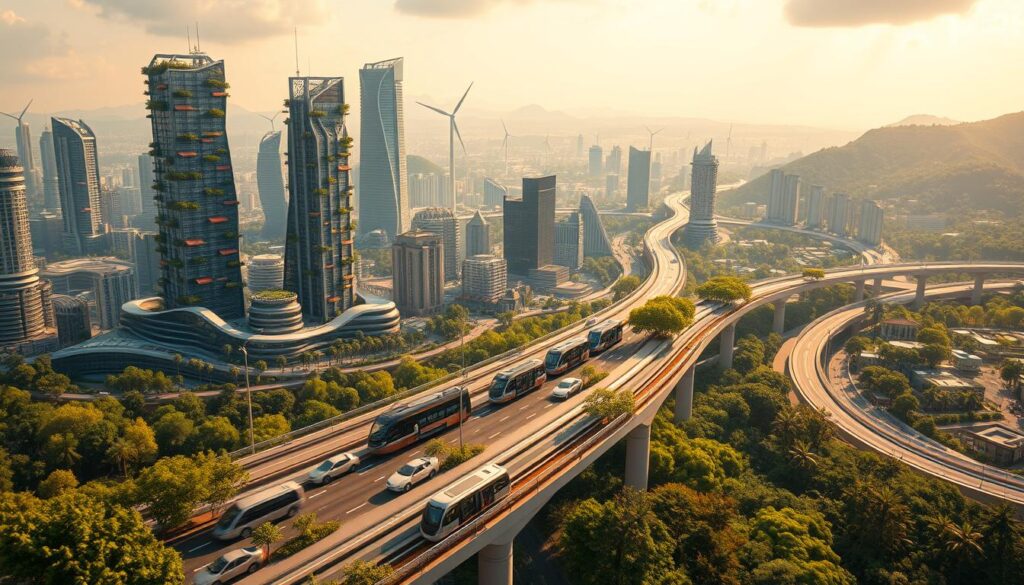
Sustainable infrastructure is on the cusp of a new era, driven by innovations in technology, policy changes, and evolving community expectations. As we move forward, it’s crucial to understand these trends to stay ahead in environmentally conscious infrastructure planning and social impact infrastructure design.
Innovations on the Horizon
Emerging technologies are set to revolutionize sustainable infrastructure. For instance, the integration of artificial intelligence and Internet of Things (IoT) devices is enhancing the efficiency and resilience of infrastructure projects. According to a report on the future of sustainable infrastructure, such technologies will play a pivotal role in shaping the industry.
Another significant trend is the use of sustainable materials and practices in construction. This includes the adoption of green building materials, which not only reduce environmental impact but also offer long-term cost savings. Innovations in material technology are expected to continue, providing more options for sustainable infrastructure projects.
Policy Changes and Their Impact
Policy changes are also on the horizon, with governments worldwide recognizing the importance of sustainable infrastructure. New regulations and policies are being implemented to encourage the development of environmentally friendly projects. For example, policies promoting the use of renewable energy sources are driving the growth of sustainable infrastructure. As highlighted in discussions on engineering the future, tackling grand challenges through policy will be crucial.
Community Impact Predictions
The impact of these trends on communities will be significant. With a focus on social impact infrastructure design, future projects are expected to not only be more sustainable but also to enhance community well-being. Predictions suggest that communities will benefit from improved public spaces, enhanced transportation systems, and more efficient services, all contributing to a better quality of life.
In conclusion, the future of sustainable infrastructure is bright, with emerging technologies, policy changes, and a focus on community impact set to drive significant advancements. By staying informed and adapting to these trends, stakeholders can ensure that infrastructure projects meet the needs of both the environment and the community.
Challenges in Implementation
The path to sustainable architecture for communities is fraught with obstacles that need to be overcome. Implementing green infrastructure development projects can be challenging due to various factors.
One of the primary challenges is funding and budget constraints. As noted by industry experts, “Securing funding for sustainable infrastructure projects remains a significant hurdle.” Effective project management is crucial to navigating these financial constraints.
Funding and Budget Constraints
Budget limitations can hinder the adoption of sustainable materials and technologies. To mitigate this, it’s essential to explore innovative financing models and cost-saving strategies. For instance, adopting a phased implementation approach can help distribute costs over time.
Resistance from Stakeholders
Resistance from stakeholders, including local communities and government agencies, can also impede progress. Engaging stakeholders through transparent communication and involving them in the decision-making process can help build trust and garner support.
“Community engagement is key to overcoming resistance and ensuring the success of sustainable infrastructure projects.”
Balancing Interests and Needs
Balancing the diverse interests and needs of various stakeholders is another significant challenge. This requires careful planning and negotiation to ensure that the needs of all parties are addressed. By prioritizing community needs and incorporating sustainable practices, it’s possible to create infrastructure that benefits everyone.
In conclusion, while implementing sustainable infrastructure projects poses several challenges, these can be overcome through effective planning, stakeholder engagement, and innovative financing solutions.
Policy and Governance for Sustainable Design
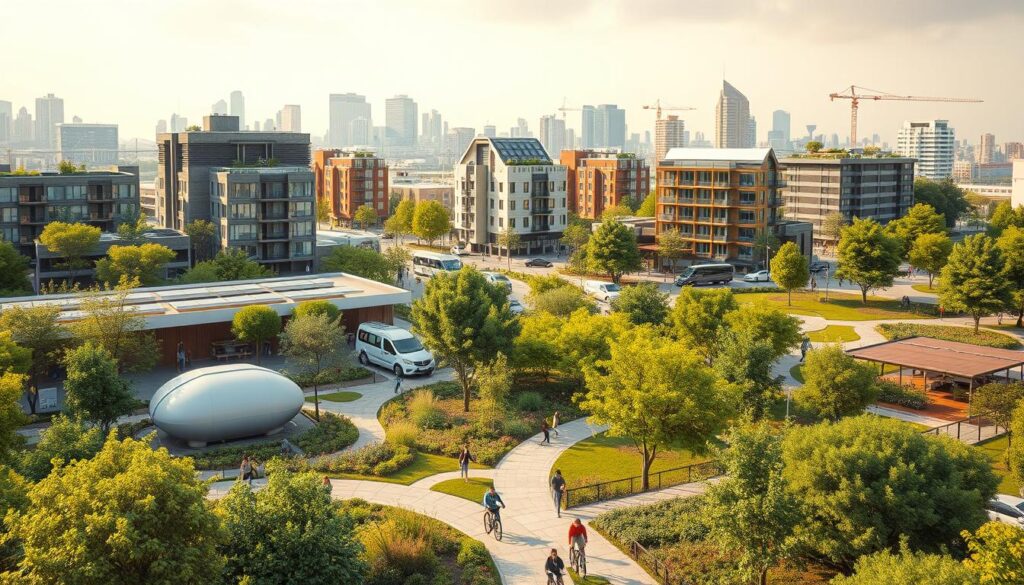
Effective policy and governance are crucial for promoting community-focused sustainable design in urban planning. A well-structured policy framework supports the development of eco-friendly infrastructure, ensuring that it meets the needs of the community while minimizing environmental impact.
Role of Local Governments
Local governments play a vital role in implementing sustainable design initiatives. They are responsible for creating and enforcing policies that support eco-friendly urban planning. By doing so, they can drive the adoption of sustainable practices and technologies within their jurisdictions.
Local governments can achieve this by establishing clear guidelines and regulations that encourage sustainable development. They can also provide incentives for developers and businesses that adopt sustainable practices.
Importance of Legislation
Legislation is a critical component of promoting sustainable design. Laws and regulations can mandate the use of sustainable materials, energy-efficient systems, and environmentally friendly construction practices. By enacting supportive legislation, governments can create a level playing field that encourages the adoption of sustainable design principles.
Moreover, legislation can provide a framework for evaluating the environmental impact of infrastructure projects, ensuring that they align with sustainability goals.
Collaborative Governance Models
Collaborative governance models bring together various stakeholders, including government agencies, private sector entities, and community groups, to work towards common sustainability goals. These models facilitate the sharing of resources, expertise, and risk, leading to more effective and sustainable infrastructure development.
By fostering collaboration and cooperation, governments can leverage the strengths of different stakeholders to drive sustainable design initiatives forward.
Education and Awareness
Promoting sustainable infrastructure requires a multifaceted approach that includes education and community awareness. As communities become more engaged in the design process, the likelihood of successful project implementation increases. Education plays a pivotal role in fostering this engagement by informing stakeholders about the benefits and challenges associated with sustainable infrastructure design.
Promoting Community Awareness
Community awareness is a critical component of social impact infrastructure design. By educating the public about the importance and benefits of sustainable practices, communities can make more informed decisions. Workshops, public meetings, and informational campaigns are effective methods for raising awareness.
Workshops and Training Programs
Workshops and training programs are essential for equipping community members and stakeholders with the knowledge needed to participate in sustainable infrastructure design processes. These programs can cover topics ranging from green building materials to energy-efficient systems. For more information on innovative approaches to community engagement, visit engineering innovation for communities.
Involving Schools and Universities
Involving educational institutions in discussions around sustainable infrastructure can have a lasting impact. Schools and universities can serve as hubs for research and innovation, providing valuable insights into sustainable infrastructure design that prioritizes community impact. By integrating sustainability into curricula, educational institutions can foster a culture of environmental stewardship among future generations.
As emphasized by experts, “Education is the foundation upon which the success of sustainable infrastructure projects is built.” This underscores the importance of prioritizing education and awareness in the pursuit of sustainable development.
“The future of our communities depends on our ability to design and implement sustainable infrastructure that meets the needs of both people and the planet.”
Conclusion: The Path Forward
As we move forward, prioritizing community needs in infrastructure design is crucial for creating sustainable, resilient communities. Top civil engineering firms like AECOM, Jacobs Engineering Group, and Stantec are leading the way in sustainable urban design solutions, focusing on community-centric sustainable development.
These industry leaders are implementing innovative technologies and strategies to create carbon-neutral designs, integrate IoT sensors, and develop connected systems. By exploring the top 10 civil engineering firms, we can gain insights into the future of sustainable infrastructure.
Prioritizing Community Needs
Future designs must prioritize community needs, ensuring that infrastructure development benefits all members of the community. This involves engaging local stakeholders, assessing community needs, and incorporating green building materials.
Call to Action
Stakeholders must work together to drive sustainable development, investing in emerging technologies and collaborative governance models. By doing so, we can create a more sustainable future for generations to come.
Vision for Sustainability
A sustainable future is within reach, with community-centric sustainable development at its core. By prioritizing community needs and leveraging innovative solutions, we can build resilient, thriving communities.
